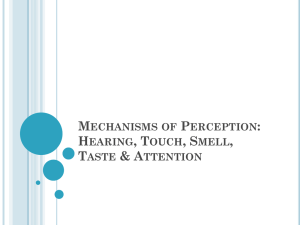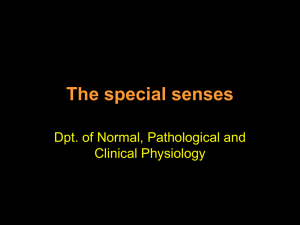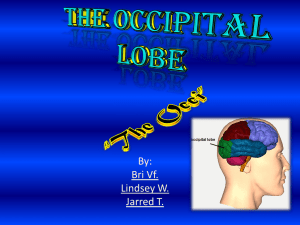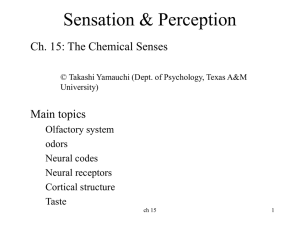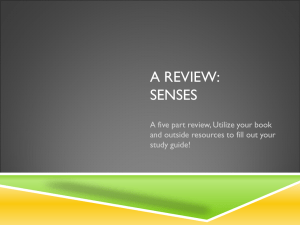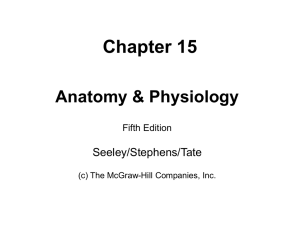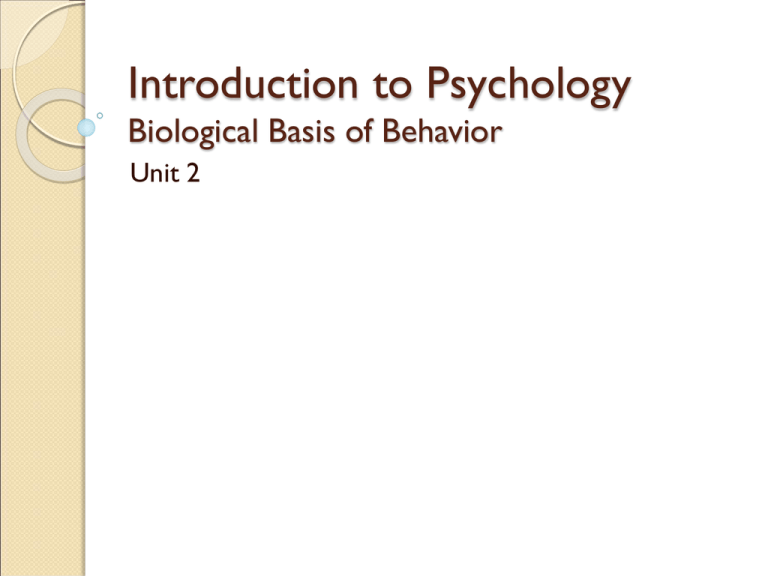
Introduction to Psychology
Biological Basis of Behavior
Unit 2
Structure of the Neuron
Soma (Cell Body): The central part of the neuron, contains
the nucleus
◦ Regulates cell functioning
Dendrites: the branching part of the neuron that receives
messages from other neurons and relays them to the cell
body
Structure of the Neuron
Axon: The long, cable-like extension that delivers messages to other
neurons
Myelin Sheath: Layer of fatty tissue that insulates the axon and helps
speed up message transmission
◦ Multiple Sclerosis: Deterioration of myelin leads to slowed communication
with muscles and impaired sensation in limbs
Structure of the Neuron
Synapse:The gap between two neurons allowing communication
◦ Chemical Synapse utilizes Neurotransmitters
◦ Electrical Synapse utilizes Action Potentials
Speed of electrical synapses depends on myelin presence
Unmyelinated neurons transmit approximately 2 meters per section
Myelinated neurons transmit approximately 120 meters per section
Six Primary Neurotransmitters
1. Acetylcholine –Firing of neurons
2. GABA- Keeps neurons from firing
3. Norepinephrine- Inhibits firing of neurons in the
CNS
4. Dopamine- Inhibitor –helps to control voluntary
movement affects sleep, mood, attention and
learning
5. Serotonin- Primarily inhibits, regulates sleep,
mood, attention and learning
6. Endorphins- Stimulates firing of neurons, shields
body from pain and elevates feeling of pleasure
The Nervous System
A.
B.
C.
D.
E.
F.
G.
Central Nervous System
Peripheral Nervous System
Somatic Nervous System
Autonomic Nervous System
Sympathetic Nervous System
Parasympathetic Nervous System
Non emergency functions
Nervous System
Structure of the Cortex
Cerebral Cortex divided
into lobes, or regions of
the brain
◦ Each lobe is (roughly)
responsible for different
higher-level functions, but
remember that they do
not work merely in
isolation.
Structure of the Cortex
Occipital Lobe: brain lobe
at the back of the head
◦ responsible primarily for
vision; separate areas
specify visual properties
such as shape, color, and
motion
Structure of the Cortex
Parietal Lobe: brain lobe at
the top and center/rear of
the head
◦ involved in registering spatial
location, attention, and motor
control
◦ also involved in arithmetic
Einstein’s parietal lobes were
found to be about 15% bigger
than average (Witelson et
al.,1999)
Structure of the Cortex
Temporal Lobe: the brain
lobe under the temples,
in front of the ears
◦ many functions, including
processing sounds,
committing information to
memory, and
comprehending language
Structure of the Cortex
Frontal Lobe: the brain lobe
located behind the forehead
◦ the seat of planning, memory
search, motor control, reasoning,
emotions, and many other
functions
◦ In many ways, the frontal lobe is
what makes us uniquely human.
Introduction to Psych
Corpus Callosum
◦ Fibers that connect the two hemispheres
◦ Allow close communication between left and right
hemisphere
Each hemisphere appears to specialize in certain
functions
Epilepsy
Neurons somewhere in brain emits
abnormal rhythmic spontaneous impulses
Brain Scans
CT or CAT Scan –X rays pass through
the head; dyes in the blood increase
contrast between fluids and brain cells
PET Scan- Position-emission tomographyhigh resolution image of brain activity by
recording radioactivity emitted from
injected chemicals
FMRI –Functional Magnetic Resonance
Imaging – magnetic detectors outside the
head to record succession scans
detection of oxygen changes
The Effects of Localized Brain
Damage
The Visual System
Damage to primary cortex –completely blind
Damage to Inferior Temporal Cortex –face
blindness
Damage to part of color pathway loss of color
constancy-ability to recognize changes in light
Unilateral Neglect
Damage to parietal lobe leads neglect or
disregard to the opposite side of the body
Individuals may put clothing on one side of the
body and insist that the other side belongs to
someone else
Memory Loss
Brain Damage
Small Portion of the frontal cortex
Delayed response
Signal from one side and delay happens
Impairment in monkeys
Connections between eye and brain
Part of the right and
left eye see almost
the same view of
the world
Left retina to the
left hemisphere of
cerebral cortex and
vice versa
Parts of the Brain and how damage
affects them
Medulla and Pons
Sensory input from head and sends impulses from motor control of
head
Axons control heart rate other life preserving functions
Systems that regulate brain arousal (reticular formation)
Malfunction in one of these systems may lead to sleepiness or
being persistently aroused
Cerebellum Cerebral Cortex
Rapid sequences of action
Important behaviours involve timing
Damage makes muscle movements slower and more thought out
Corpus Callosum –sensation and motor control on opposite
side of body
Parts of the Brain and how damage
affects them
Primary Cortex
Neurons sensitive to touch
Damage cause complete blindness
Inferior Temporal Cortex
Part of visual system
Damage may cause face blindness
Parietal lobe
Body senses –touch, pain, and temperature, awareness of the
location of body parts
Damage may cause unilateral neglect
Temporal lobe
Hearing complex aspects of vision, and language comprehension
Damage results in impariment in individuals ability to understand
what someone is saying or remebering objects when one is
speaking
Genetics
Zygote- Fertilized Egg
◦ Monozygotic vs Dizygotic Twins
Genes are made up of DNA a chemical that controls RNA
Homozygous- Two genes where the pairs are the same
Heterozygous- Two genes where the pairs are different
Identifying Genes
Researchers have found some genes to contribute to Alzheimer's
and Huntington's disease
Researching
Hereditability Ranges from 0 to 1
Measure of 1 indicates all variance id due to heredity
Measure of 0 suggests none is due to heredity
Genetics
Interactions between Heredity and the
Environment
PKU-Phenylketonuria inherited condition leads to
retardation
Evolution
Changes in gene frequency species
Selective Breeding: Artificial selection of animals and
plants
Natural selection: Individuals with certain charcteristics
reproduce more successfully
Socio-biology attempts to connect social behaviour of
species to its biology
Genetics
The Visual Senses
Stimuli
Receptors
Genetics
Heredity - transmission of trait from one
generation to next
Chromosomes
◦ Pairs of thread like bodies that contain genes
Deoxyribonucleic acid (DNA)
◦ Organic molecule arranged in a double-helix
◦ Contains the “code of life”
Genetic Concepts
Nucleic Acids
◦ DNA
◦ RNA
Chromosomes
◦X
◦Y
◦ Karyotype Chromosomal Maps
Genetic Concepts
Genotype : What is in the DNA
Phenotype: What is observable as a
result of the genotype
Carrier vs Expressed Genetics
Multifactorial & Polygenic Factors
Gene-Environment Interaction
Twin Studies!
◦ Monozygotic
Twins
◦ Dizygotic
Twins
Genetic Abnormalities
Down’s Syndrome aka Trisomy 21
◦ Three copies of Chromosom 21 present
◦ Characteristics:
Thick tongue
Round face
Slanted eyes
Short limbs
Cognitive delays, occasional mental retardation
More prone to dementias and age-related disease
early in life
Genetic Abnormalities
Phenylketonuria aka PKU
◦ Metabolic disorder leading to inability to
digest proteins
◦ 1/5,000 US births
◦ Recessive linked
◦ Dietary treatment available
◦ Can be detected prenatally and through
standard newborn testing
Genetic Abnormalities
Huntington’s Disease
◦ Dominant linked
◦ Symptoms begin around age 35
◦ Manifests as mental illness and extreme
aggression
◦ Typically ends in suicide
◦ Can be screened for in genetic testing
Sex-Linked Abnormalities
Kleinfelter Syndrome: XXY Chromosomal
Pattern
◦ Seemingly male appearance with an absence
of secondary sex characteristics typically
present at puberty
◦ Learning disabilities, language deficits, and
anger issues are common
Sex-Linked Abnormalities
Fragile X Syndrome: Part of the X is thinly
attached and prone to breaking
◦ One gene mutation replicates over 200 times
(normal range is 30)
◦ Enlargement of the head and ears are typically
present
◦ Males may have enlarged scrotum and testicle
◦ May lead normal lives (20%)
◦ Mild retardation (30%)
◦ Severe retardation (47%)
Sex-Linked Abnormalities
Turner’s Syndrome: XO Genetic mutation,
only one chromosome present
◦ Learning disabilities (particularly
math/science/logical reasoning)
◦ Flat affect and difficulty recognizing emotions
◦ Short stature
◦ Secondary sex characteristics and puberty
changes do not develop
◦ “Webbed” neck sometimes present
Behavior Genetics
Study of behavior from a genetic
perspective
Animal behavior genetic studies include:
◦ Strain studies
◦ Selection studies
Human Behavior Genetics
Family studies
◦ Assume that close family members share
more of a trait than non-relatives
◦ Used to assess the heritability of
psychological disorders or traits
Twin studies
◦ Used to determine how heritable a trait or
disorder may be
◦ Identical twins would have highest heritability
Human Behavior Genetics
Adoption studies
◦ Used to assess the influence of environment
Molecular genetics
◦ Direct study of the genetic code
Structure and Function of the
Human Eye
Disorders involving Vision
Presbyopia –decreased flexibility in lens
difficulty focusing on nearby objects
Myopia –elongation of eyeballs- far objects
Hyperopia – flattened eyeballs- farsighted
Glaucoma- increased pressure in eyeball
leading to optic nerve damage
Cataract- lend becomes cloudy
The Visual Receptors
Neurons in the retina
specialized to respond to
small quantities of light
Cones –Color, daytime,
detailed Vision 5 to 10%
visual receptors – 6 million
per eye
Rods – receptors adopted
vision in dim light – 100
million per eye
Visual Pathways
Bipolar Cells –make
contact with other
neurons
Ganglion Cells- receive
input from bipolar cells
Optic Nerve- Ganglion cell
axions join to form the
optic nerve
Color Vision
Trichromatic Theory aka Young-Helmoltz Theory
Three primary colors
3 types of Cones
Blue Cones-Sensitive to short wavelengths
Green Cones- Sensitive to medium wavelengths
Red Cones- respond to long wavelengths
Color Vision
Four basic primary colors
◦ Blue
◦ Green
◦ Red
◦ Yellow
Erwald Hering – opponent process
theory
◦ Negative after images
◦ Color Constancy
◦ Retinex Theory
Color perceived through cerebral
cortex
Colorblindness
◦ 4%
◦ Most common is red green distinguishing
◦ More common in men
Color Vision
Hearing
Process of Hearing:
◦ Auricle directs sound waves to the external auditory
canal
◦ Sound waves strike the tympanic membrane causing
vibrations.
Low-frequency sounds cause slow vibrations
High-frequency cause fast vibrations
◦ Vibrations cause the malleus to vibrate, which vibrates the
incus, which vibrates the stapes.
◦ Movement of the stapes pushes the membrane of oval
window open & closed.
Hearing
Process of Hearing:
◦ Vibrations of the oval window cause the perilymph of
the cochlea to move in waves.
◦ Waves move to the scala vestibuli, the scala tympani,
then to the round window.
◦ The waves cause the round window to bulge into the
middle ear & the walls fo the scala vestibuli & scala
tympani to change.
◦ Wall changes cause pressure waves in the endolymph
inside the cochlear duct.
◦ Waves in the cochlear duct cause vibration of the basilar
membrane.
◦ Cochlear waves move the organ of Corti hairs against the
tectorial membrane.
Hearing
Process of Hearing:
◦ Tectorial membrane vibrations cause receptor
potentials, then nerve impulses, via opening
potassium channels.
◦ Auditory Pathway travels from the first-order
sensory neurons in the cochlear branch of the
vestibulocochlear nerves (CN 8) to the
medulla oblongata.
◦ Signal travels from the medulla oblongata to the
midbrain, to the thalamus, then the temporal lobe
for conscious perception.
Hearing
Tuning: Basilar membrane is divided into
pitches.
◦ High intensity sound waves create longer
vibrations & creates an interpretation of high pitch.
◦ Low intensity sound waves create shorter
vibrations & creates an interpretation of low pitch.
Equilibrium
Equilibrium: The sense of balance
maintained by our inner ear.
◦ Static Equilibrium: Refers to our ability to keep
our position in response to gravity.
◦ Dynamic Equilibrium: Refers to our ability to
keep our body position in response to sudden
movements.
Equilibrium
Vestibular Apparatus: The receptor organ
responsible for maintaining equilibrium.
Typically maintained by the saccule & utricle within
the vestibule of the inner ear.
◦ Macula: A small patch of hair cells on both the saccule &
utricle. Contains around 50 stereocilia & a single motile
kinocilium.
◦ Otolithic Membrane: Thick, gelatin-like layer of
glycoproteins weighted down by otoliths (calcium crystals).
◦ Shifting the head causes changes in these structures that
generate nerve signals.
Equilibrium
Semicircular Ducts: The three ducts, each
containing ampulla, help to maintain balance.
◦ Crista Ampularis: Mounds of hair on each
ampulla.
Cupula: Gelatinous material covering the crista
ampularis.
◦ Changes in these structures help to maitain
dynamic equilibrium.
Sensory Receptors
Sensory receptors transmit 4 types of information:
◦ Modality: Refers to the type of stimulus or sensation it
produces.
E.g. vision, hearing, taste.
◦ Location: Determined by which afferent (sensory) nerve
fiber are firing & gives the brain the ability to identify the
site or location of the stimulus.
◦ Intensity: Determined by the number & kind of nerve
fibers which are firing & the time intervals between action
potentials.
◦ Duration: Refers to the way nerve fibers change their
firing frequencies over time.
Classification of Sensory Receptors –
General
Somesthetic (General) Senses: Includes
receptors in the skin, muscle, tendons, joint capsules,
and viscera.
◦ Somatic Senses: Tactile senses, thermal sensations, pain
sensations, proprioceptive sensations.
◦ Visceral Senses: Provides information about conditions
within the internal organs.
Special Senses: Limited to the head & innervated
by the cranial nerves.
◦ Includes:Vision, hearing, equilibrium, taste & smell.
Classification of Sensory Receptors –
Overlapping Systems
Chemoreceptors: Respond to chemicals, including odor &
taste.
Thermoreceptors: Respond to temperature (heat & cold).
Nociceptors: Pain receptors.
Mechanreceptors: Respond to the physical deformation of
the plasma membrane.
◦ E.g. caused by touch, pressure, stretch, tension, or vibration.
Photoreceptors: Respond to light.
Osmoreceptors: Respond to osmotic pressure.
Proprioreceptors: Sense the body position, muscle tension,
& movement in space.
Pain Sensation
Nocioceptors: Pain sensory neurons found
in every bodily tissue except the brain.
Analgesia: The relief of pain.
◦ Oligopeptides: Chemicals released by the CNS
that have analgesic qualities. AKA edogenous
opiods.
E.g. Endorphins & dynorphins.
Types of Pain
Slow Pain: Dull, achey pain signals carried along an
unmeylinated neuron.
Fast Pain: Sharp, stabbing, sudden pain signals carried along a
myelinated neuron.
Superficial Somatic Pain: Pain felt by receptors in the skin.
Deep Somatic Pain: Pain felt in the muscles, joints, tendons,
and fascia.
Visceral Pain: Pain sensation from the receptors in the
visceral organs.
Referred Pain: Pain caused by an organ or specific area but
felt in other areas served by the same spinal nerve.
Kinesthesia
Kinesthesia: The perception of body
movements.
Proprioceptors: Sensory receptors that can
sense the location of body parts, their
movements, & muscle tension without visual
input.
◦ Mostly done through the hair cells in the inner ear
responsible for balance & equilibrium.
Muscle Spindles: Involved in our stretch
reflexes.
Smell
Olfaction: The sense of smell.
◦ Located in the nose – around 20 million receptors!
Olfactory Receptors: First-order neurons whose dendrites
contain the olfactory hairs (cilia) that respond to chemicals.
◦ Only sensory receptor in contact with the outside world.
◦ Receptors are replaced every few months.
◦ Supported by… Basal stem cells, Columnar supporting cells
and..
Olfactory glands (aka Bowman’s glands): Produce the mucus that
moistens the epithelium.
Olfactory Epithelium: Contains most of the olfactory
receptors.
Odorant: A chemical responded to by the olfactory hairs.
Smell
Olfactory Epithelium: Contains most of
the olfactory receptors.
Hyposomia: The gradual loss of smell as we
get older.
Process of Smelling
Odorants (chemicals) bind to the Olfactory
Receptors.
◦ Odorants must be water-soluble, volatile, & reach the
minimum threshold to be detected.
Olfactory receptors send a signal to the
Olfactory Nerves (Cranial nerve 1).
Signal continues to the Olfactory Bulbs (first-order
neuron) & synapses with the Olfactory Tract
(second-order neuron).
Signal is then transmitted to the brain, through the
cortex & on to the thalamus to be perceived.
Taste
Gustation: The chemically-based sense of taste. 5
Primary Tastes:
◦
◦
◦
◦
◦
Sweet: Least sensitivity.
Sour
Bitter: Most sensitive.
Salty
Umami: Meaty or Savory flavor.
Flavor: A combination of taste, smell, and texture.
MOST of taste perception is driven by scent.
Taste
Taste Buds: Small organs made up of several
components that allow us to perceive taste.
◦ Over 10,000 total, mostly on the tongue.
◦ Can be located on the papillae.
Taste
Components of a taste bud:
◦ Gustatory Receptor Cells: Around 50 total in
each taste bud.
◦ Taste Pore: A small opening in the top of the
taste bud.
◦ Gustatory Hair: Projects through the taste pore
to help trap chemicals to analyze.
Taste
Papillae (elevations on the tongue that give it
a rough texture). 4 types:
◦ Vallate Papillae: Twelve large circular papillae
forming an inverted V at the back of the tongue.
Each contains a few hundred taste buds.
◦ Fungiform Papillae: Mushroom-shaped papillae.
Each contains around give taste buds.
Found all over the tongue.
Taste
◦ Foliate Papillae: Found in the trenches on the
sides of the tongue.
These taste buds degenerate rapidly.
◦ Filiform Papillae: Threadlike papillae found all
over the tongue.
Contain no taste buds.
Contain tactile receptors to detect texture.
Increase friction between the tongue and food & move
food around in the oral cavity.
Taste
Tastant: Any chemical that stimulates our taste.
◦ Each tastant stimulates the receptors in a different way.
◦ G-Proteins: A specific protein some tastants must be
linked to in order to reach threshold.
Facial Nerve (CN 7) and Glossopharyngeal
Nerve (CN 11) serve the tongue.
Vagus Nerve (CN 10) serves the throat and
epiglottis.
Taste
Pathway of Taste Perception:
◦ Taste bud to the appropriate cranial nerve
◦ Cranial nerve to the gustatory nucleus in the
medulla oblongata
◦ Medulla oblongata to the thalamus
◦ Thalamus to the gustatory cortex
Interpreting Sensation
Absolute Threshold
Difference Threshold
Sensory Adaptation
Depth Perception
Visual Consistency
Shape Consistency
Size Consistency
Depth Perception
Binocular Cues
◦
◦
◦
◦
◦
Retinal Disparity
Convergence
Accommodation
Binocular Parallax
Binocular Disparity
Depth Perception
Monocular Cues
◦
◦
◦
◦
Relative Size & Height
Linear Perspective
Detail
Interposition
Visual Cliff
Depth Perception
Monocular Cues
◦
◦
◦
◦
Texture Gradient
Motion Parallax
Shadow
Familiar Size
Visual Cliff
Movement Perception
Induced Movement
Stroboscopic Movement
Optical Illusions
Optical Illusions
Ames Room
Sleep
Circadian Rhythms
◦ Jet Lag
◦ Graveyard Shifts
◦ Shift Work
Two Theories of the Purpose of Sleep:
◦ Repair & Restoration Theory
◦ Energy-Conservation Theory
Freud’s Theory – Reveal unconscious thoughts &
motivations
Contemporary Theory
◦ Activation-Synthesis Theory
◦ Neurocognitive Theory
Sleep
Stages of Sleep
Sleep
Stages of Sleep
Sleep Abnormalities
Insomnia
Sleep Apnea
Narcolepsy
Sleep Talking
Sleep Walking
Nightmares
Night Terrors
Hypersomia
Hypnosis
1st “Discovered”
by Franz Mesmer
Theory: Posthypnotic Suggestion
Meditation a form of hypnosis?
Effects of Drugs
Depressants
◦ Alcohol
◦ Tranquillizers
◦ Marijuana
Stimulants
◦ Methamphetamines
◦ Cocaine
Effects of Drugs
Opiates
◦
◦
◦
◦
◦
Opium
Morphine
Heroin
Methadone
Codeine
Hallucinogens
◦ LSD
◦ PCP
◦ Mescaline

